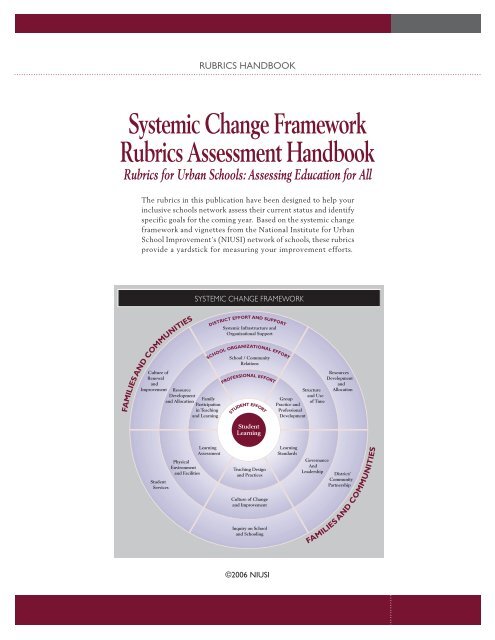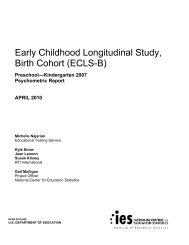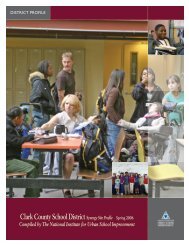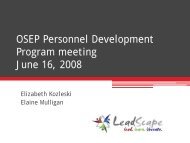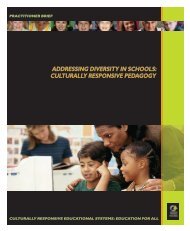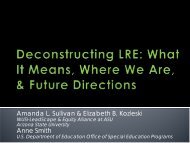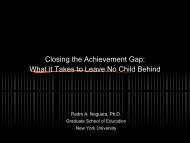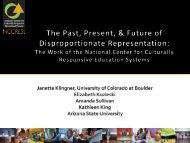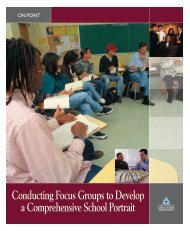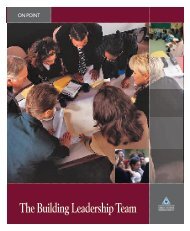Systemic Change Framework Rubrics ... - NIUSI Leadscape
Systemic Change Framework Rubrics ... - NIUSI Leadscape
Systemic Change Framework Rubrics ... - NIUSI Leadscape
You also want an ePaper? Increase the reach of your titles
YUMPU automatically turns print PDFs into web optimized ePapers that Google loves.
RUBRICS HANDBOOK<strong>Systemic</strong> <strong>Change</strong> <strong>Framework</strong><strong>Rubrics</strong> Assessment Handbook<strong>Rubrics</strong> for Urban Schools: Assessing Education for AllThe rubrics in this publication have been designed to help yourinclusive schools network assess their current status and identifyspecific goals for the coming year. Based on the systemic changeframework and vignettes from the National Institute for UrbanSchool Improvement’s (<strong>NIUSI</strong>) network of schools, these rubricsprovide a yardstick for measuring your improvement efforts.<strong>Systemic</strong> change frameworkCulture ofRenewalandImprovement ResourceDevelopmentFamilyand AllocationParticipationin Teachingand LearningFamilies and communitiesdistrict effort and support<strong>Systemic</strong> Infrastructure andOrganizational SupportSchool / CommunityRelationsschool organizational effortprofessional effortstudent effortStudentLearningGroupPractice andProfessionalDevelopmentStructureand Useof TimeResourcesDevelopmentandAllocationLearningAssessmentPhysicalEnvironmentand FacilitiesStudentServicesTeaching Designand PracticesCulture of <strong>Change</strong>and ImprovementInquiry on Schooland SchoolingLearningStandardsGovernanceAndLeadershipDistrict/CommunityPartnershipFamilies and communities©2006 <strong>NIUSI</strong>
2A <strong>Framework</strong> forSchool SystemsWe need a common framework for understanding thechange work that we do. The framework must be groundedin the system that we seek to change: public education.For the last seven years, <strong>NIUSI</strong> has used the <strong>Systemic</strong><strong>Change</strong> <strong>Framework</strong> to guide its practice in schools (seeFigure 1). It helps our district, school, family andpractitioner partners understand what part of the system aparticular strategy may target. It reminds us all that thecore of our work must be successful learning results forstudents. The framework reminds us that school systemsare products of the communities and the families that livethere. In the framework, family and communityinvolvement are embedded actions at the district, schooland professional levels.Each element of the framework defines the arenas in whichleadership needs to emerge at that level. For instance,districts need to ensure that policies are developed andimplemented that help individual schools make the best useof all the resources in a particular building. Schools need tobe organized in ways that create space for teachers to havetime to plan and learn together. Professionals need tounderstand and implement robust processes for assessing andteaching their students. Different types of activities anddifferent roles people are highlighted in each of the levels ofthe framework. Such complex contexts require thatstrategies are differentiated, complementary, and coherent inorder to leverage continuous change and improvement.The Inclusive Schools<strong>Rubrics</strong>: AssessingImprovementintroduction The following rubrics have beendesigned to help your inclusive schools network assess theircurrent status and identify specific goals for the comingyear using the systemic change framework as the criterionof measurement. Application of the framework through therubrics provides a yardstick for measuring yourimprovement efforts.Organization The rubrics are aligned with each sectionof the <strong>Systemic</strong> <strong>Change</strong> <strong>Framework</strong> (SCF). The ratingslevel spectrum range from Beginning ↔ Developing ↔ AtStandard ↔ Leading. Benchmarks were established basedupon evidence from <strong>NIUSI</strong>’s network of schools. TheBenchmarks provide a yardstick for measuring yourimprovement efforts.SCF SectionProfessionalEffortRubricSchoolEffortRubricDistrictEffortRubricAssessment Each rubric provides a tool for assessing yourwork according to the standards established in the <strong>Systemic</strong><strong>Change</strong> <strong>Framework</strong>. When assessing your progressaccording to the SCF, use concrete examples as specificevidence that chronicles the work that you haveaccomplished.Rating System The ultimate goal is to move your schoolinto a Leading Learning Community. Align the work thatyou have done to the criterion set in each rubric to determinewhere your efforts fall along the spectrum. The ratingsinclude the following range: Beginning; Developing;At Standard; and Leading.AppendicesIntended UsersTeachers, Para-Professionals andother professionals who engage instudent learning.School administrators, teachers,parents, community members andother professionals who providesupport to the organizationalstructure of schools.District administrators, schooladministrator and, BuildingLeadership Team Members.Appendix A: Vignettes This section provides a set ofvignettes that illustrates specific examples at standard.
3Professional Effort <strong>Rubrics</strong> The first set of rubrics helps assess the work of teachers and otherprofessionals (social workers, psychologist, therapist, etc.) who engage student learning. Make sure that youback up each rating with specific, concrete evidence.Beginning Developing At Standard leading LearningStandards• No collaborative planning;goals set in isolation.• School recognizes thatacademic goals should belinked to school outcomesand to developing thenecessary social and personalskills to accomplish goalswith students and adults.• Instructional staff usesdialogue to collaborativelyset goals that are targetedtowards results for studentsuccess.• School communityrecognizes the need to usestudent data to set goals butis unsure about how to usedata to set new goals.• Some grade level teams areworking collaboratively tomeet school goals.• Intermediate timelines toreview progress on schoolgoals are set.• Peers engage each other inreflective conversationsabout improving practicethat are grounded in studentwork and outcomes.• The whole school communityannually examinescomprehensive data and setslearning goals and standardstogether. Learning goals andstandards address the wholeperson and support postgraduationsuccess.Professional development isembedded in the daily life ofthe school and supportsongoing improvement ofpractice tied to the targetedlearning goals and standardsof both students and adults.LearningAssessment• Assessment comes at the endof the instructional cycle andis primarily used todetermine student progress.• Data about studentperformance is documented,but not gathered in asystematic way.• Assessment is viewed asimportant to ongoingmonitoring of studentprogress; practitioners use avariety of tools for informingtheir practice.• Student performance data isavailable for practitioner useand organized in a systemicand accessible manner• Practitioners use assessmentsas a means to inform theirown learning aboutindividual and group needs. Avariety of achievement andperformance tasks provideongoing information aboutstudent learning.• Student performance dataacross grades and levels areused consistently bypractitioners to improveinstruction; students andteachers work collaborativelyto assess learning.• Assessments are designed anddeveloped in an equitableand fair manner thateliminates sources of bias ordistortion and supportpersonalized instruction forall learners. Students andteacher conduct selfassessmentsto continuouslyimprove performance.Improvements in studentachievement are evident andclearly caused by teachers’and students’ understandingsof individual studentlearning, linked toappropriate and effectiveinstructional and assessmentstrategies. A continuum oflearning is evident and nostudent fails to achieve.Teaching Designand Practice• Teachers use differentapproaches to teaching basedon their own preferences.• Teachers determine academicneeds/learning approachesbased on intuition andjudgment.• Teachers’ practices reflectgaps and differences in theirculture competence.• Teaching practices targetshort-term results.• Teachers discuss learningneeds of students andrecognize variation inlearning needs.• Reflection begins about howto track and analyze studentneeds, learning approaches,and achievement trends.• Cultural competence isunderstood to mean morethan recognition of studentdiversity.• Some lesson design andimplementation reflects thevariation in student learningneeds and approaches.• Practitioners begin to workcollaboratively to aligninstruction with standardsand assessment withobjective indicators of qualitystudent achievement.• Teaching practices reflect acoherent understanding ofdiversity; differentiatedinstruction supportsindividual and grouplearning.• Practitioners continuouslyassess, reflect and improvetheir practices in response tostudent and communityneeds both individually andcollectively.• Good to excellentachievement is evident witheach and every student.• Practitioners’ teachingdesigns and activities aredifferentiated, and includemultiple measures of studentperformance based on bothindividual and collaborativeprocesses.
4Professional Effort <strong>Rubrics</strong>Beginning Developing At Standard leading Group Practice andProfessional Learning• Practitioners rely primarilyon outside experts forprofessional developmentthat is set by the district orschool administration.• Professional development isselected by individualteachers and not necessarilytied to the school goals.• Classroom practices aredeveloped primarily inisolation.• Conversations about inschoolexpertise areconducted.• The school communitydiscusses moving fromepisodic to job embeddedprofessional development.Instructional strengths andneeds are identified and tiedto student learning standards.• Grade level teams collaborateto study their practice andinvestigate co-teachingmodels.• Supports are in place forfostering a variety ofprofessional developmentopportunities within theschool. Practitioners identifyneeds based on group inquiry.• Practitioners consistently usea variety of embeddedprofessional developmentprocesses, including studygroups, inquiry teams, andteam teaching. Risk-taking isencouraged.• Improved student learning isthe primary focus of anyprofessional developmentconversation.• Collaborative networks are inplace that support and createa coherent and seamlessinstructional program forstudents.• Professional developmentprograms for staff focusdirectly on the knowledgeand skills required to fulfillthe performance expectationsof their roles and tocontribute to theachievement of the goals forimprovement.• A “teaching as inquiry” stanceis evident across the schooland community wideconversations focus onstudent and learning.
5School Organizational Effort <strong>Rubrics</strong> The next set of rubrics helpsassess the work of the school to support teacher and other practitioner efforts.Make sure that you back up ratings with specific, concrete evidence.Beginning Developing At Standard leading School /CommunityRelations• School climate is notinclusive of individual staff,family, and studentexperiences.• Students tend to gather insimilar peer groups.• The school communityprimarily relies on punitivediscipline strategies.• Rules and policies are createdand enforced by school staff.School/communityrelationships are tenuous andstrained.• Adults begin to includestudent needs in planning anddefine student centeredlearning communities.• Students participate in focusgroups and other vehicles forunderstanding studentperspective on the schoolclimate.• The school communitybegins to gather informationon its current approach tosupporting positive behaviorof all students.• The school begins to evaluateits role in the community anddiscuss ways to improve thisrelationship.• The school communityselects and beginsimplementation of strategiesto support studentparticipation andcollaboration in decisionmaking.• Some adults take on studentmentoring roles.• Some students assume rolesfor mentoring, supportingand sanctioning each other’sconduct.• The school has provided avariety of ways forcommunity and parents toinput into school functions.• Every student is accepted,has a valued role, and is seenas a contributor to thelearning culture.• Students and adults assumeresponsibility for mentoring,supporting, and sanctioningconduct.• School and community workseamlessly together to createa supportive learningcommunity for all studentsand adults.• The school extends theschool community throughcollaborative networks ofsupports for student learning.• Previously non-achievingstudents enjoy learning withexcellent achievement.• Community businesses andhomes become commonplaces for student learning,while school becomes a placewhere parents come forfurther education.Resource Developmentand Allocation• School is a closed, isolatedsystem; partnerships existprimarily for money andmaterials.• School identifies highturnover of staff as a criticalissue related to studentachievement.• Resources are allocatedcategorically; principal makesbudgetary decisions based onfunding sources andindividual teacher requests.• School has knowledge ofimportance of partnershipsbeyond a source of fiscalsupport.• Leadership team gathers datafrom teachers that identifyissues related to teacherretention and attrition.• Allocation of resources isequitable but not targetedstrategically. Leadership teamstudies budgetary processesfrom other successful modelsand develops a plan thataligns resources with schoolgoals.• School seeks effective winwinbusiness and communitypartnerships and parentinvolvement to implementthe vision. Some adults takeon student mentoring roles.• Desired outcomes are clearlyidentified. A solid plan forpartnership developmentexists.• Plan for improved leveragingof resources is implemented;feedback loops are used toassess the effectiveness of theplan.• Community, parent, andbusiness partnerships becomeintegrated across all studentgroupings. All knows thebenefits of outsideinvolvement. Parent andbusiness involvement instudent learning is refined.Student learning regularlytakes place beyond the schoolwalls.• Resources are stewarded insuch a way that they supportthe work of schools andpractitioners, and areeffectively leveraged tosupport student learning.• Staff turnover is low.
6School Organizational Effort <strong>Rubrics</strong>Beginning Developing At Standard leading Structure andUse of Time• The school is organizedaround traditionalstructures; schedule andassignments makecollaboration within theschool day difficult.• Support services maintaintheir traditional roles asproviders of a particularservice, with littleintegration into classroominstruction.• Traditional policies existthat maintain isolationamong teachers during theworkday.• Grade level planning timeis incorporated into theschool day and processesfor effective use of thistime are developed.• Leadership team developsa plan for integratingsupport services intoclassroom instruction time;study groups meet outsideof the workday to assesscurrent use of supportservices.• Leadership team studiesexisting policies related tostructure and use of timeto assess how they mightbetter facilitate improvedstudent learning.• Organization of the schoolday provides time forcollaboration within andacross grade levels.• Processes for effective use oftime are honed and revised,with input from all staff.• School implements the planfor integration of supportservices staff into theclassroom; study groups meetwithin the workday to assessthe effectiveness of theimplementation.• Leadership team developspolicies that support flexibleuse of schedules andassignments.• Leadership team supportimplementation of nontraditionalschedules(extended day or year roundschool) as needed.• The school is effectivelyorganized to maximize teachercollaboration across grade levelsand feeder schools. Planning andreflection time are incorporatedinto the workday and focus on theimprovement of student and adultlearning.• All support services staff are anintegral part of the planningprocess among teams and theirexpertise is honored and valued.• Policies document the school’sbelief that schedules andassignments must be flexible toensure effective use of schoolpersonnel and time in order tomaximize student learning.Governance andLeadership• A shared decision makingstructure is put into placeand discussions begin onhow to achieve a schoolvision. Most decisions arefocused on solvingproblems and are reactive.• School values and beliefsare identified; the purposeof school is defined; aschool mission and studentlearning standards aredeveloped.• A structure for studyingapproaches to achievingstudent learning standardsis established.• Leadership team iscommitted to continuousimprovement. Leadershipseeks inclusion of allschool sectors and supportsstudy team by making timeprovisions for their work.• Leadership team is activeon student teams andintegratesrecommendations from theteams’ research andanalyses to form acomprehensive plan forcontinuous improvementwithin the context of theschool mission. Everyone iskept informed.• Some data are collected onstudent background andtrends. Learning gaps arenoted to directimprovement ofinstruction. It is knownthat student learningstandards must beidentified.• Leadership team represents atrue shared-decision makingstructure. Study teams arereconstructed for theimplementation of acomprehensive continuousimprovement plan.• Decisions about budget andimplementation of the visionare made within teams, bythe principal, by theleadership team, and by thefull staff as appropriate. Alldecisions are communicatedtot the leadership team andto the full staff.• There is a systematic relianceon hard data (including datafor subgroups) as a basis fordecision-making at theclassroom level as well as atthe school level. <strong>Change</strong>s arebased on the study of data tomeet the needs of studentand teachers.• A comprehensive, effective,continuous improvementstructure exists that supportsparticipation from all sectors ofthe school, district, andcommunity, enduring strongcommunication, flexibility, andrefinement of approach andbeliefs.• The vision is implemented andarticulated across all grade levelsand into feeder schools. Qualitystandards are reinforcedthroughout the school. Allmembers of the schoolcommunity understand and applythe quality standards.• Leadership team has systematicinteractions and involvement withdistrict administrators, teachers,parents, community, and studentsabout the school’s direction.• School makes an effort to exceedstudent achievementexpectations. Innovativeinstructional changes are made toanticipate learning needs andimprove student achievement.Teachers are able to predictcharacteristics impacting studentachievement and to know how toperform from a small set ofinternal quality measures.
7School Organizational Effort <strong>Rubrics</strong>Beginning Developing At Standard leading Physical Environmentand Facilities• Desks in rows or chairs allfacing forward• Bare walls or onlycommercial posters• List of consequences formisbehavior or rules createdby an adult• Student work does notappear authentic• Frequent and extendedperiods of silence and/orteachers’ voice most oftenheard• Teacher typically front andcenter• Teacher voice controlling,condescending, or too sweet• Building upkeep is donesporadically and on an asneeded basis, but theleadership team begins toaddress this issue.• Safety policies are discussedonly after a crisis or eventoccurs. .• Building upkeep and physicalenvironment are thoughtfullyplanned for over a period ofyears and involve the wholestaff.• Safety policies are discussedand reviewed annually tomeet the changing needs ofthe school community.• A safe atmosphere existswithin the school, in terms ofboth physical structures andpersonal safety.• This safe atmosphere isprotected and evaluatedcontinuously as a necessarycomponent of improving theschool.• School pride is evidentamong staff, students, andcommunity, who worktogether to maintain physicalcleanliness and schoolattractiveness.• Authentic examples ofstudent work areappropriately displayed on aregular basis.Culture of <strong>Change</strong>and Improvement• Professional development isepisodic and not linked toexplicit instructionalimprovement goals.• School climate is based onindividual on individualexperiences.• Summative but not formativeevaluation occurs..• The school plan and studentneeds are used to targetappropriate professionaldevelopment for allemployees. Staff receivestraining relevant toinstructional and leadershipstrategies.• Leadership team and studygroups study and define themeaning of student-centeredlearning communities.• Study groups assess theeffectiveness of evaluationprocesses and makerecommendations forongoing, constructivefeedback for staff.• Professional developmentand data-gathering methodsare used by all teachers andare directed toward the goalsof continuous improvement.Teachers have ongoingconversations about studentachievement research.• Data from a variety ofsources informs theleadership team and staffabout the school climate;action plans are created tosupport conditions that resultin productive change andcontinuous.• Teachers support one anotherwith peer coaching andinquiry focused on processesthat lead to increased studentlearning.• Leadership and staffcontinuously improve allaspects of the schoolstructure through aninnovative andcomprehensive continuousimprovement process thatprevents student failures.Professional development isappropriate for theimplementing the vision,supportive, collegial,effective, systemic, andongoing. Traditional teacherevaluations are replaced bycollegial coaching and inquiryfocused on student learningstandards.• A climate exists in whichstudents and adults feelvalued, belong to the schoolcommunity and are able totake both academic and socialrisks.• School and community workseamlessly together to endurethat the needs of each andevery student are met.
8District Effort <strong>Rubrics</strong> The next set of rubrics helps assessthe work of the district to support its schools. Make sure that ratingsare backed up with specific, concrete evidence.Beginning Developing At Standard leading Infrastructure andOrganizational Supports• The district is organizedbureaucratically andrigidly. Supports aredifficult and cumbersome.• The district solicitscommunity feedbackabout issues that it targetsas important. Thisfeedback may or may notbe used in decisionmaking.• The district is organized withsome cross-departmentalroles and relationshipsoccurring.• A district level administratoris responsible for a set ofschools and primarily servicesas an evaluator.• The district’s mission andvision are developed, but thesystem does not fully operatearound a common purposeand shared understanding.• The community identifiesissues around which theyprovide feedback tot hedistrict. Feedback loops areestablished that serve to keepall stakeholders informed.• The district is organized insuch a way that the roles,relationships, and rules arearticulated and integratedacross departmentalboundaries. Data systemsprovide timely feedback tostakeholders.• A district level administratoris responsible to a schoolfeeder pattern to providecoherent support andassistance.• The district’s mission andvision are developed with avariety of participants, whichserves as a set of “guidingprinciples” for decisions andplanning across the system.• The district and communityconsistently collaboratearound issues and challengesidentified jointly.• The district has replaced acompartmentalized, rule-drivenculture with a culture that iscross functional in decisionsharing, working arrangements,flexible teams, and individualand collective reflection oneffective practices.• Each building has a district leveladministrator who mentors thebuilding to coordinate andsupport technical assistance andprofessional development.• The district’s mission and visionare context-based, compellingand operate so that thefollowing are evident across thesystem:• The purpose of schools.• The role of the family andcommunity in relation tostudents and schools.• The kind of society for whichstudents are being prepares isevident in the district.• The obligation of the system toemployees and the role of thesystem in encouraging andsupporting innovation.Resource Developmentand Allocation• The district providesschools information aboutexternal funding sources.Some support is availablefor grant writing andtechnical assistance.• Resources to schools areprovided uniformly.• Retention of dual certified.teachers is viewed as thepurview of the school.• Unions and districtmaintain separate agendas.• Internal and externalresources are identified bydistrict for the purpose ofimproved alignment offunding.• Equitable funding for schoolsis identified as important forachieving high outcomes forall students; the districtdevelops a plan for leveragingavailable resources.• The district seeks out theunions for input on teacherretention, attrition, and otherissues.• Technical assistance andprofessional developmentopportunities and funds aremade available based on needfor improvement on a schoolby-schoolbasis• The district brokers resourcesfrom a variety of sources tosupport school improvementplans and efforts.• The district activelycollaborates with unionpersonnel for the purpose ofretaining quality staff.• The district is service-oriented,serving to reach all students inthe district--public, charter, andmagnet. The district usesstudent achievement andplacement data to developresources allocation plans,considering internal & externalresources, resulting in equitabledistribution of resources for allschools.• Staffing resources are allocatedto increase the number of highquality teachers assigned tostruggling schools.• Resources from externallyfunded projects and initiativesare leveraged with otherresources.• Ongoing collaboration amongdistrict, schools, unions, andcommunity provides for strongpolicies and procedures forretaining quality staff andremoving unsatisfactory staff.
9District Effort <strong>Rubrics</strong>Beginning Developing At Standard leading StudentServices• Student services are• District personnel gatherorganized vertically bydata that identifiesfunction, i.e. specialorganizational needs foreducation, English as aimproving services to schools.second language, mentalA plan is developed forhealth, school safety w/little implementation.or no functional collective • Services to students areservice coordination,provided through periodicdelivery, technicalcollaboration acrossassistance, or professional departments. More defined,learning.integrate services to schoolsare discussed.• Schools are required to staffand deliver student servicesin specific, mandated ways.• A system is in place forsupporting the renewal andimprovement of schools thatis coherent and proactive.• Student services areorganized across functionsand delivered to age groups .i.e., preschool, elementary.Schools develop servicedelivery plans based on need.• Special education resourcesare delivered directly toschools, and resources usedacross the school.• A coherent system supportsand promotes school renewaland improvement through: aprimary focus on studentneeds with student servicesallocated accordingly,proactive rather than reactiveresponse to schools; in timeresponses to changing schoolneeds.• Seamless services to schoolsare provided throughhorizontal and crossdepartmentalteaming of allspecialists, including specialeducation and related services,language and literacy services,athletics, and the arts as wellas the curriculum andinstruction professionals.• The district has developed andimplemented efficient,effective strategies forsupporting and sustaining therequests of schools forservices.District/CommunityRelationships• Some partnerships exist; • The district operates on thethese are viewed as external assumption that partnershipsto the district and serve to with local universities &augment programs andcolleges, businesses andbuilding needs.families, enhance access toresources improve,professional learning &practice, and createadditional opportunities tolearn.• The district has anorganizational structure inplace to attract & developpartnerships.• The district establishesstrategic partnerships andsustains them overtime usinga continuous improvementprocess.• Partnerships thatdemonstrate impact onstudent learning are fosteredand nurtured.• The community engages in anongoing assets mappingprocess that involves the faith,business, education,commerce, and non-profitcommunities resulting inproductive and sustainablepartnerships that are inspiredand sustained from with in andoutside of the LEA.
10District Effort <strong>Rubrics</strong>Beginning Developing At Standard leading Culture of Renewaland Improvements• Some partnerships exist; • Professional development isthese are viewed as external fragmented and menu driven.to the district and serve to • School improvement is ties toaugment programs andadoption of school reformbuilding needs.models and specificprograms; adult and studentlearning needs emanate fromthese models and programs.• Networking among schoolsoccurs sporadically and on anas needed basis.• Professional development isrecognized as job-embedded,and district structures andprocesses support schools sothat the decisions about adultlearning occur at the buildinglevel.• Learning standards for adultsand students provide theframework for schoolimprovement. The district,schools, and communityjointly identify programs andmodels that align with thesestandards.• Networking amongprofessionals occurs regularlywith the school day andprovides multipleopportunities for learning.• A culture exists that supportsgrowth and developmentpersonally, professionally, andorganizationally across thesystem. Risk-taking andfailure are seen asopportunities for growth.• A pervasive, relentless focuson student learning andstudent outcomes drive thecommitment to the fact thatimproving student learningdepends on the continualinvestment in andimprovement of adultlearning, including districtpersonnel and families.• Teaching is a publicenterprise that thrives on thecontinuous networking ofprofessionals and communityfor the purpose of improvingthe outcomes for each andevery student.Inquiry on Schooland Schooling• Inquiry on schools exists toidentify successful schoolsand support schools indistress.• Identification ofunderachieving schoolsoccurs at a point in timebefore the end of the schoolyear so that improvementstrategies can be planned andimplemented.• Data on student learning arecollected and shared withschools through traditionalvenues; feedback loops arevariable and access toinformation is problematic.• A variety of inquiry projectsare developed that occuracross the school year for thepurpose of providing schoolswith timely data.Practitioners are encouragedto engage in inquiry projectsthat examine practices fordiverse learners.• District personnel develop aplan for improved feedbackloops to schools thatimproves access to a varietyof data.• The community is surveyedabout their perceptions ofschools and schooling.• District personnel areinvolved in a variety ofongoing projects that involvepromising practices, policyanalysis, and support ofpractice-based inquiry.• Data on student achievementare received in a timelymanner by building so thatleadership teams can targetschool improvement goalsand professionaldevelopment efforts for thenext year.• The needs and satisfactions ofparents and other communitymembers are regularlyassessed; generated data isused by schools to identifyand act on issues.• The District website houses aset of inquiry and datacollection tools as well aslongitudinal data that areavailable to buildings forinquiry purposes.• Schools are recognized fortracking and using data onstudent climate, familyinvolvement, studentachievement, et. to makethoughtful, systemic andprogrammatic improvementto their work, resulting inimproved outcomes for eachand every student.• A shared understandingexists among all stakeholdersabout the nature ofschooling; diversity is valuedfor its contributions to theschool environment, culture,and teaching practices.
11What does your systemicframework look like?• Use a green highlighter to indicateelements that you are at or abovestandard• Use a yellow highlighter to indicateelements that you are developing• Use a red highlighter to indicateelements that you are beginningOnce you color yoursystemic framework,consider these questions:Culture ofRenewalandImprovementFamilies and communitiesResourceDevelopmentand AllocationFamilyParticipationin Teachingand Learningdistrict effort and support<strong>Systemic</strong> Infrastructure andOrganizational Supportschool organizational effortSchool / CommunityRelationsprofessional effortstudent effortStudentLearningGroupPractice andProfessionalDevelopmentResourcesDevelopmentandAllocationStructureand Useof Time1 How robust are efforts at alllevels of the system?2 Is there a particular level that seemsnoticeably stronger than others?3 Are there areas that seem critical tocontinued growth?4 What kinds of assets currently exist?5 What assets will you need to improve?StudentServicesPhysicalEnvironmentand FacilitiesLearningAssessmentTeaching Design andPracticesCulture of <strong>Change</strong> andImprovementInquiry on School andSchoolingLearningStandardsGovernanceAndLeadershipDistrict/CommunityPartnershipFamilies and communities
12Overview of Your ResultsDistrictElement Resources Development & AllocationDistrict/Community PartnershipInquiry on School & SchoolingStudent ServicesCultural Renewal & Improvement<strong>Systemic</strong> Infrastructure & Organizational SupportschoolElement School/Community RelationsStructure & Use of TimeGovernance & LeadershipCulture of <strong>Change</strong> and ImprovementPhysical Environment & FacilitiesResource Development & AllocationprofessionalElement Learning StandardsLearning AssessmentTeaching Design & PracticesGroup Practice & Professional DevelopmentFamily Participation in Teaching & Learning
13Your PathReflect on your data by answering the following questions.Make sure that you give everyone a chance to offer theirperspectives as you discuss your answers. Use the pictureabove to map your path.• What other contexts are important for understandingwhere you are and where you want to be?• Who benefits by the way things are?• Who is disadvantaged by the way that things are?• Who should be present as you make plans for the future?• Where do you want your school to be in three years?• Where do you want to be in two years?• Where do you want to be by this time next year?• What steps do you need to take in the next threemonths to reach your goals?• Who do you need to enlist?PATH PROCESSdiversityParentsandCommunitychangeacceptanceandCommunityschoolimprovementWhat <strong>Change</strong>Should Occur?Who DoWe Enlist?What ResourcesDo We Need?NextWeek2 3 4 53Months6Months1Ideal /Outcome ...The School’s North Star
14Appendix AP r o f e s s i o n a l E f f o r tLearning Standards Learning Standards are critical to the learning environment and support student effort inproviding students with the knowledge of “what it is we need to know and be able to do” in the classroom and in schools.”At Standard PrimaryGradesGrades3-5Grades6-9Grades10-12Every class focuses on higher order thinking skills through reciprocal teaching approach.Teachers revise report cards to address new standards.Every literacy standard is matched to a set of approaches to literacy teaching that are adopted and universally used across grades.Learning standards are posted in every classroom.Students complete quarterly evaluations of their teachers in relationship to accomplishing specific literacy standards.Teams meet to work out the requirements of graduation i.e. academic vs. non academic diplomaLearning Assessment Leearning assessment helps teachers understandthe knowledge and skills of each student while defining goals for learning.At Standard PrimaryGradesGrades3-5Grades6-9Grades10-12Teachers meet to devise accommodations for state testing materialsTeachers use running records to assess literacy and math progress on a student by student basis.Teachers meet to assess student work products on a weekly basisTeachers use assessment to inform instructionDepartments develop accommodations and adaptations to standards testsAssessment is formative, embedded and summativeStudents’ grades are earned by standard, not by courseA variety of assessment formats are used to meet the needs of learnersTeaching Design & Practice Practitioners thrive and are better able to innovate, support studenteffort and outcomes when their organization supports and encourages their creativity and professionalism.At Standard PrimaryGradesGrades3-5Grades6-9Grades10-12Classrooms focus on the writing process1/3 of the day spent in small group activities1/3 of the day spent in large group activities1/3 spent in active learning activitiesCross-age tutoringThematic UnitsUse of co-teaching models for inclusionCoaching used to follow-up differentiated instruction inserviceCo-teaching and scheduling are used to foster inclusive practicesThe language teacher handed out the rubric for performance standards so that studentscould pre-assess their competencies before direct teaching began. Students determined whatthey already knew and what they had to learn to receive the highest performance gradeVertical teaming to share practicesInterdisciplinary teams are used to connect student learning
15P r o f e s s i o n a l E f f o r tGroup Practice & Professional Development The literature on effective and inclusive schools, in addition toidentifying specific educator practices, also highlights the need for collaboration among and between general and special educators.School professionals need support, training, and coaching in order to implement high quality, inclusionary practices effectively.At Standard PrimaryGradesGrades3-5Grades6-9Grades10-12Staff study of learning styles and how they affect children.Self-study on student motivation to learn.A group of 2nd grade teachers met regularly to coach and support their work.Vertical teaming to align instruction and teaching.Grade level teams collaboratively develop into learning communitiesThe speech language teacher teaches language lessons to the whole class using the content of whatever the teacher is teaching thatday i.e., medieval history might be a vocabulary matching game played in cooperative groups.Teachers teamed with TCs to use inquiry to understand gender equity issues.House teams integrate curricula across content areas of English, social studies, math and science.Students with disabilities meet with core teachers to identify specific accommodations and modifications that need to be used toaccomplish each quarter’s standards.Family Participation in Teaching & Learning Practitioners Urban schools need families not only to supportschool efforts outside of school, but more importantly, to contribute to the ongoing mission and operations of the school.At Standard PrimaryGradesGrades3-5Grades6-9Grades3-5Parents are invited to actively participate in student learning in and out of school.Teachers meet to devise accommodations for state testing materialsTeachers use running records to assess literacy and math progress on a student by student basis.Teachers meet to assess student work products on a weekly basisTeachers provide parents with strategies to facilitate home learning.Parents are apprised of state and district requirements for academic progress.Parents are actively involved in school improvement planning process.Departments develop accommodations and adaptations to standards testsStudents’ grades are earned by standard, not by course
16S c h o o l O r g a n i z a t i o n a l E f f o r tSchool/Community Relationships Close school/community relationshipsare at the heart of successful, comprehensive, and inclusive urban schoolsAt Standard PrimaryGradesGrades3-5Grades6-9Grades10-12PTA organized services night. Brought in community services people.Partnership established with local businessesTransition days in the spring of each year for 5th graders and 8th graders. After school tutoring and activity programFamily nights with food prepared by high school students for each house each quarter.Resource Development & Allocation In a transformed, inclusive school learning and other educational supports areorganized to meet the needs of all students rather than historical conventions or the way the rooms are arranged in the building.At Standard PrimaryAll GradesGrades3-5Grades6-9Grades10-12Reallocation of textbook money to purchase trade books for teachers. The hiring team states it inclusion philosophy and askscandidates to discuss their approach to inclusion of students with disabilities. Pay for performance. On-going professionaldevelopment is available to keep staff abreast of strategies for more inclusive instruction.Aligned with school improvement plan to support goals. Principal releases teachers for coaching.Separate administrators for each house. Teacher candidates in this partner school release teachers for planning and coaching timeSeparate administrators and special services teams for each house. Involvement of counselors in class-basedself-determination groups. Active recruitment of teacher candidates from local partner schoolsStructure & Use of Time Without time during the work day to meet, discuss, and challenge oneanother’s ideas and activities, it is difficult to imagine many educators achieving the quality of dialogue andinquiry necessary for sustained, whole school improvement.At Standard PrimaryGradesGrades3-5Grades6-9Grades10-12Use of parent volunteers to host reader’s and writer’s workshops. All students in the general education classroom.Each grade level has a support person who works directly in the classroom. This person may be thespeech/language therapist, the special educator, the Title 1 specialist or the child advocate.Early release day once a week. All students in the general education classroom.Special educators serve as in-class technical assistance support and co-teachers.Common prep time. All students assigned to home room in general education. Each team has a learning specialist whoteaches a fourth class--the learning specialist supports a full class load of diverse learners like all the other classes.Common prep and governance time for each house.Common advising time for all students.
17S c h o o l O r g a n i z a t i o n a l E f f o r tGovernance & Leadership The most challenging students require the combined expertise of many individuals includingadministrators, teachers, mental health personnel, community advocates, and students themselves. The use of building-level leadershipteams creates the opportunity for shared decision-making resulting in important benefits to students with and without disabilities.At Standard PrimaryGradesGrades3-5Grades6-9Grades10-12Staff involvement in inquiry group professional development focused on school-centered making.School improvement plan is a working document that is used by all teachers to guide work.BLT targeted improved CSAP--developed plan that supports timely use of assessments.Three grade-level houses. BLT developed plan for improved communication and feedback loops across the building.School within a school vertical cohorts of students. House-based leadership teams.Physical Environment & Facilities By using the space and equipment thoughtfully, school professionals can reducethe amount of talking they do to manage the group and increase the time students spend learning the explicit curriculum.At Standard PrimaryGradesGrades3-5Grades6-9Grades3-5Classrooms have a variety of age appropriate tables, chairs, desks, floor mats.Students art work is displayed throughout building.Science classes develop projects that target beautifying the school grounds.Classrooms located in the same area of the school.All students are engaged in service projects to enhance the building’s appearance.Computer , science and math classrooms include appropriate furniture.Culture of <strong>Change</strong> & Improvement A school must provide the intellectual and emotional climate tosupport sustained improvement of practice. Teachers and other practitioners must use the informationthat students provide about their learning progress to inform curriculum and teaching decisions.At Standard PrimaryGradesGrades3-5Grades6-9Grades3-5Professional development in the form of coaching, inquiry teams, visitations to other schools.Practitioners use grade level planning and co-teaching to enhance student learning.Practitioners host team reflective work group meeting.Use of portraiture to examine strengths and barriers.
18D i s t r i c t E f f o r t & S u p p o r tInfrastructure & Organizational Supports The functions of central administration must beorganized in such a way that efficiency and individualization are accommodated. Thoughtful supports provide coherent,continuous opportunities for improved practices.At Standard PrimaryGradesGrades3-5Grades6-9Grades10-12AllGradesLevelsLiteracy and math coaches assigned to each school as a part of staff. Monthly meetings of literacy andmath coaches to disseminate information and instructional strategies to be used in schools.Literacy and math coaches assigned to each school as a part of staff. Monthly meetings of literacyand math coaches to disseminate information and strategies to be used in schools.Content area team leaders selected by school administrator to act as team leaders. District supportedmonthly meetings to disseminate information and instructional strategies to be used in schools.Content area team leaders selected by school administrator to act as team leaders. District supportedmonthly meetings to disseminate information and instructional strategies to be used in schools.• Professional development at the district is driven by school improvement targets; buildingteams are networked; a focus is placed on the development of skill at the building level.• Each building has a district level administrator who is assigned to the building tocoordinate and support technical assistance and professional development.• All schools are linked via email and the Web.Just In Time Feedback Cycles• Data on student achievement are received by building in May so that leadership teamscan target school improvement goals and professional development efforts for the next year.• The District web-site houses a set of inquiry and data collection tools that are available to buildings for inquiry purposes.• District personnel provide rapid turn around for data analysis.Resource Development & Allocation Districts strategically andflexibly develop and allocate resources to support the work of schools.At Standard AllGradesLevelsScaling Up & Down to maximize Resources• Technical assistance and professional development opportunities are madeavailable on the basis of need for improvement on a school by school basis.• Schools are rewarded for tracking and using data on student climate, family involvement, studentachievement to make thoughtful, systemic and programmatic improvements to their work.Investing in School-Individualized Ongoing Professional DevelopmentResources for professional development are focused on school improvement strategiesand target professional development delivery models that have demonstrated high levelsof practitioner change such as classroom coaching, peer coaching, and practice-based inquiry.Student Services A range of services are available to students and families that involve practitionersother than teachers that are designed to realize all students’ potential.At Standard All GradesLevels• Services to students are organized by preschool, elementary, middle and secondary teams that include special education andrelated services, language and literacy services, athletics and the arts as well as the curriculum and instruction experts.
19D i s t r i c t E f f o r t & S u p p o r tDistrict/Community Partnership For many of the same reasons individual schools need to partnerwith families and communities, districts need to partner with their local judicial, social, recreational, healthand government agencies to ensure that students are able to attend school ready to learn.At Standard All GradesLevels• The district engages in an ongoing assets mapping process that involvesthe faith, business, education, commerce, and nonprofit communities.Culture of Renewal & Improvements Through professional development schools, theresearch values of teacher educators are combined with the primary concern of schools to find solutionsto practical problems. Risk-taking and failure are seen as opportunities for growth.At Standard AllGradesLevels• Every school leadership team has an opportunity to showcase its school improvement process, identify the risksthat it is taking for improving learning outcomes for all students and receive feedback from critical friends.• An annual inquiry conference is hosted by local school districts.• District leadership sets clear, annual goals that target the improvement of services and learning outcomes for student at the margins.• Families have regular opportunities to provide input about school services.Inquiry on Schools & Schooling Educators, families, and students areengaged in ongoing reflection and practice-based inquiry in classrooms and schools.At Standard All GradesLevels• District personnel are involved in a variety of inquiry projects that involvepromising practices, policy analysis, and support of Practice-Based inquiry.
gREAT URBAN SCHOOLS:vProduce high achieving students.vConstruct education forsocial justice, access and equity.vExpand students’ life opportunities,available choices and community contributions.vBuild on the extraordinary resources thaturban communities provide for life-long learning.vUse the valuable knowledge and experience thatchildren and their families bring to school learning.vNeed individuals, family organizations and communities towork together to create future generations of possibility.vPractice scholarship by creating partnershipsfor action-based research and inquiry.vShape their practice based on evidence of whatresults in successful learning of each student.vFoster relationships based on care,respect and responsibility.vUnderstand that people learn in differentways throughout their lives.vRespond with learningopportunities that work.Great Urban Schools: Learning Together Builds Strong Communities
g RUBRICS HANDBOOKNational Institute forUrban School ImprovementARIZONASTATEUNIVERSITYPO BOX 872011TEMPE, ARIZONA 85287-2011PHONE : 480.965.0391FA X: 480.727.7012EMAIL: <strong>NIUSI</strong>@ASU.EDUWWW.URBANSCHOOLS.ORGFUNDED BY THE U.S. DEPARTMENT OF EDUCATIONOFFICE OF SPECIAL EDUCATION PROGRAMSAWARD NO. H326B020002PROJECT OFFICER: ANNE SMITHGreat Urban Schools: Learning Together Builds Strong Communities


